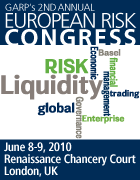Ms. Schmidt Bies wanted to tie the theme of GARP's conference (Transforming Risk in a New World Order) to emphasize some risk management failures in the recent economic crisis. Specifically she aimed at mortgage and commercial real estate lending. She likened the crisis to the movie Groundhog Day, in which the main character is doomed to re-live the same day everyday until he learns his lesson. For our purposes, a real estate crisis grips some part of this country on average every ten years. It appears our Groundhog Day schedule runs in ten year cycles.
For Ms. Schmidt Bies, the problem did not rest on hedge funds or in derivatives or in private equity. The crisis landed squarely on the shoulders of mortgage and real estate lending. Let's looks at some of the facts:
- Between 2004-2006, new home sales were over one million, well above the growth in number of households--thus, a surplus in houses came about.
- Investor demand normally occupies 1/12 of the sales of new homes. During the bubble, investor demand ranged from 40-60%--hence, speculation abounded.
- Banks were reaching outside their traditional, market footprints. For example, North Dakota banks were making loans in Florida, well outside their footprint.
- Banks lost sight of what lending should be: they were based on asset-priced lending versus being based on the ability to repay.
- Credit models were inappropriate for lending. FICO, for example, worked in the 1990s when there was no bubble. FICO measures a willingness to pay rather than an ability to pay, thus no good for the housing bubble. Loan types changed as well: no dock loans and complex loans came into vogue, and they were peddled to those with lesser levels of financial literacy. 228 loans, with their automatic, periodic payment jumps, were passed on too easily.
In short, Ms. Schmidt Bies says when you have a market failure you cannot rely on market mechanisms to correct the mistakes.
On Fannie Mae and Freddie Mac: the entities were pressured to buy the junk mortgages and to push the American dream of home ownership (not good things).
On Basel II and risk-based capital: how does one measure liquidity risk? More liquidity should equal more capital. When systemic risk is addressed lack of liquidity is often overlooked.
Leading up to the crisis, Ms. Schmidt Bries says there was too much reliance on VaR models. The lookback periods were way too short, often just 100-200 days. This short attention fueled a downward spiral of bad risk measurement and its consequent investments. Tails, not variances, need more attention. One only goes to capital for unusual and unforseen events - stress testing will assist in correcting these oversights.
Ms. Schmidt Bries says leverage ratios are not good as well. She is concerned over Basel discussions about this because capital held is supposed to be based on assets. But, a) every asset is not equally risky, and b) when based on assets, one often ignores risks off the books (see Bear Sterns).
There are also accounting issues that need tackled, especially for marked-to-market non-trading assets and liabilities. These were highly leveraged during the bubble and needed to be drastically de-leveraged when the bubble burst. Fair value accounting is needed.
In closing, Ms. Schmidt Bries wants to know: what are risk managers going to do to make sure Groundhog Day in the financial world is not going to be re-lived again? Historic precedence should sound alarm bells. Currently too much risk is siloed; CROs need to open risk management to other business units.
Up next: panel on executive risk managers






0 comments:
Post a Comment